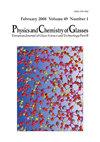玻璃结构的XAFS研究
IF 0.3
4区 材料科学
Q4 CHEMISTRY, PHYSICAL
Physics and Chemistry of Glasses-European Journal of Glass Science and Technology Part B
Pub Date : 2020-12-12
DOI:10.13036/17533562.61.6.DALBA
引用次数: 0
摘要
x射线吸收精细结构(XAFS)光谱已成为表征凝聚态物质中特定原子种类局部配位的最重要技术之一。研究非晶材料结构的可能性使XAFS在研究玻璃态的短程结构方面具有很大的吸引力。XAFS缩写表示存在于x射线吸收边缘之上的结构;这种结构被区分为x射线吸收近边结构(XANES)和扩展x射线吸收精细结构(EXAFS)。XANES携带了吸收物质周围原子排列的信息:距离和成键角度。XANES还提供了有关导带附近电子状态的信息:可以从光谱中的已知特征识别不同的化学环境。EXAFS提供了吸收物质最近邻居的平均距离和径向分布函数的信息。近十年来,随着同步辐射设备的发展,实验技术的巨大进步和实验光谱的优良质量,促进了XAFS理论和分析方法的发展。本文综述了XAFS的理论发展和测定无序材料中短程信息的方法。报道了XAFS在一些玻璃体系统中的应用。本文章由计算机程序翻译,如有差异,请以英文原文为准。
XAFS studies of glass structure
X-ray absorption fine structure (XAFS) spectroscopy has become one of the most important techniques to characterise the local coordination of specific atomic species present in condensed matter. The possibility of investigating the structure of noncrystalline materials has made XAFS very attractive for the study of the short range structure of the glassy state. The XAFS acronym denotes the structure present above the x-ray absorption edges; such a structure is distinguished as x-ray absorption near edge structure (XANES) and extended x-ray absorption fine structure (EXAFS). XANES carries information on the atomic arrangement around the absorbing species: distances and bonding angles. XANES also provides information on the electronic states in the proximity of the conduction band: different chemical environments may be identified from known features in the spectrum. EXAFS provides information on the average distance and radial distribution function of the nearest neighbours of the absorbing species. In the last decade, the enormous progress of experimental techniques and the excellent quality of experimental spectra, consequent to the development of the synchrotron radiation facilities, have stimulated the evolution of the XAFS theory and analysis procedures. This paper is a survey on the theoretical development of XAFS and on the methods for determining the short range information in disordered materials. Applications of XAFS to some vitreous systems are reported.
求助全文
通过发布文献求助,成功后即可免费获取论文全文。
去求助
来源期刊

CiteScore
0.70
自引率
33.30%
发文量
0
审稿时长
1 months
期刊介绍:
Physics and Chemistry of Glasses accepts papers of a more purely scientific interest concerned with glasses and their structure or properties. Thus the subject of a paper will normally determine the journal in which it will be published.
 求助内容:
求助内容: 应助结果提醒方式:
应助结果提醒方式:


